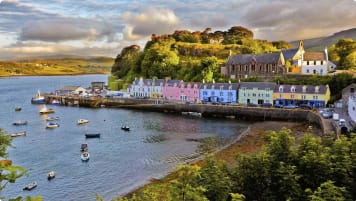Shetland Islands Discovered: The Definitive Guide for Travellers
Article for senior and mature travellers, couples or solo travelers, interested in visiting the Shetland isles of Scotland. Explore on a small group tour to learn about the Bronze age, standing stones, peat and whisky and more when visiting the Scottish isles.
26 Jul 21 · 14 mins read

Shetland Islands Discovered
Scotland’s Shetland Islands (or simply, Shetland) is a group of more than 100 islands, only 16 of which are inhabited, with a pristine coastline unrivalled in all of the United Kingdom. Its capital is Lerwick, with a population of 7,500 – which represents a third of the total population of the Shetlands.

Sitting on the Atlantic Ocean northeast of the Scottish mainland, the Shetland Islands are the northernmost point of Britain, sharing the same latitude as St Petersburg in Russia. The islands are much closer geographically to Norway (320 kilometres) than they are to London (960 kilometres). In many ways, the Shetland Islands are also culturally closer to Scandinavia, with historical roots in the Viking invasions of the 8th century.
In this article, we will look at the history and heritage of this unique destination, and the places to visit when touring the islands, with a special focus on the Shetland Mainland.
History of the Shetland Islands
Picts
The first settlers of the Shetland Islands were the Picts. The name comes from the Roman picti, or ‘painted ones’, believed to be due to their habit of painting dye on their bodies (though modern historians have doubted the truth of these claims). They were said to have migrated from Scythia (Scandinavia) before settling and forming powerful kingdoms in what is now northern Scotland.
The Picts were more of a confederation of tribes rather than a single tribe, and did not leave written records behind, save for the symbols carved on standing stones which can still be found throughout Scotland. What we know of them we know from Roman and other historical records, where they were mentioned from around the year 300 to the year 900, after which historians believe that they were incorporated into other cultural groups. The Romans tried numerous times to invade the Picts’ territory, but were thwarted each time. While England and Wales fell under Roman rule, the Picts drove the Romans out and attacked the walls Hadrian had built to protect Roman Britain.
The Picts were responsible for the creation of intricately carved ‘standing stones’, which today dot the landscape of mainland Scotland, the Inner and Outer Hebrides, and of course, the Shetland and Orkney Islands. For more about Pictish stone carvings, take a look at our article about Britain’s Neolithic Past. In Shetland, one can visit Hjaltadans, also known as Fairy Ring or Haltadans stone circle, one of three stone circles in Shetland. A ring of 38 stones on the isle of Fetlar, ancient legend has it that that the circle of stones was once a circle of dancing trolls and that the two rock pillars in its centre were a fiddler and his wife. The group danced to the fiddler all night long and, unaware of the time, were still fiddling and dancing when the sun rose and petrified them all.
In the 7th century, the Picts fought Northumbrians in the decisive Battle of Dun Nechtain (Dunnichen). To quote the BBC, “If the Picts had lost, Scotland might never have existed.”
The Islands as Dowry
Much like the Faroe Islands, recently written about on this blog, the Shetland Islands came under the rule of Vikings around the year 800. Like the Faroe Islands, the Shetland Islands had an Althing (Norse parliament) established.
Lindsey Porter writes in Shetland Islands (The Horizon Press, 2010) that the Althing was established in Tingwall, whose name still carries this Viking heritage. Things, from the Old Norse þing, was used to describe these Viking assemblies, and survives in the place names across Northern Europe, such as Tinganes (Faroe Islands), Dingwall (Scotland), and Tynwald (Isle of Man).
The Vikings would rule the islands for approximately 600 years. At first the islands were used as a home base by Viking pirates. To protect his maritime interests against them, Harald Fairhair, the first King of Norway, annexed Shetland in 875. From that year until the 13th century, the Norwegian throne had control of the Viking earldom of Shetland and Orkney, Shetland’s neighbouring group of islands located 80 kilometres to the south-west.
In 1397, a Scandinavian union was formed at Kalmar, Sweden (Kalmar Union) bringing the separate kingdoms of Norway, Sweden, and Denmark under a single monarch. In 1468, Christian I, King of a united Norway, Sweden, and Denmark, could not produce the dowry to give James III of Scotland, his daughter’s husband-to-be, and ended up pledging Orkney and Shetland.
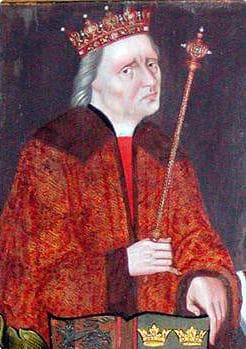

The dowry was never paid, and the Kalmar Union, (no) thanks to the impoverished King Christian, ended up losing territory. Shetland, along with Orkney, was officially annexed to Scotland in 1472 and fell under the rule of Scottish kings.
Norse Heritage in Shetland
After centuries of forging a deep connection with Scandinavia, the Shetland Islands was suddenly infused with a new culture and a new language (not to mention a new ruler). Of course, thousands of years of influence cannot be completely undone, and so aspects of Norse culture and practice continue to survive to this day, more than 500 years after the end of Norwegian rule on the islands.
Let’s start with language. The people of Shetland spoke Norn, the old and now extinct Norse language, until the 18th century. Christine de Luca, a Scottish poet who also writes poems in Shetlandic, describes the Shetland dialect as “Old Scots (which is related to Middle English) with a strong Norse influence.” De Luca adds: “Today it is fascinating to discover how Scandinavian writers I have met perceive the Shetland tongue – they see it as a cousin language, recognisable yet strange.”
Norn words are preserved in place-names and in words related to the Shetland way of life, such as fishing and farming, or words related to the sea and nature. The Faroe Islands‘ modern language is closer to Norn, and a Faroese speaker will be able to recognise many Shetland words. For example, the Faroese word for their national bird the oystercatcher is “tjaldur”; in Shetland it’s “shalder”, the two words sharing very similar pronunciation.

Lerwick, the capital, has a “King Harald Street” in honour of the Norwegian king. Houses in Shetland are often built in a Scandinavian style, and it is common to see Norwegian flags flown.
Shetland’s Up Helly Aa, a midwinter festival held in January to mark the end of the yuletide season, was originally a fire festival (featuring mischief-making and the dragging of barrels of burning tar through town) dating back to the 1880s; it later drew inspiration from Shetland’s Viking roots and became a celebration of the islands’ Norse heritage. It features the Guizer Jarl (jarl=earl) and his Jarl Squad who wear a Viking suit of armour, and the unveiling of a Viking Galley built and painted by local tradesmen. The official ceremony ends with flaming torches thrown into the galley, followed by a night of revelry.
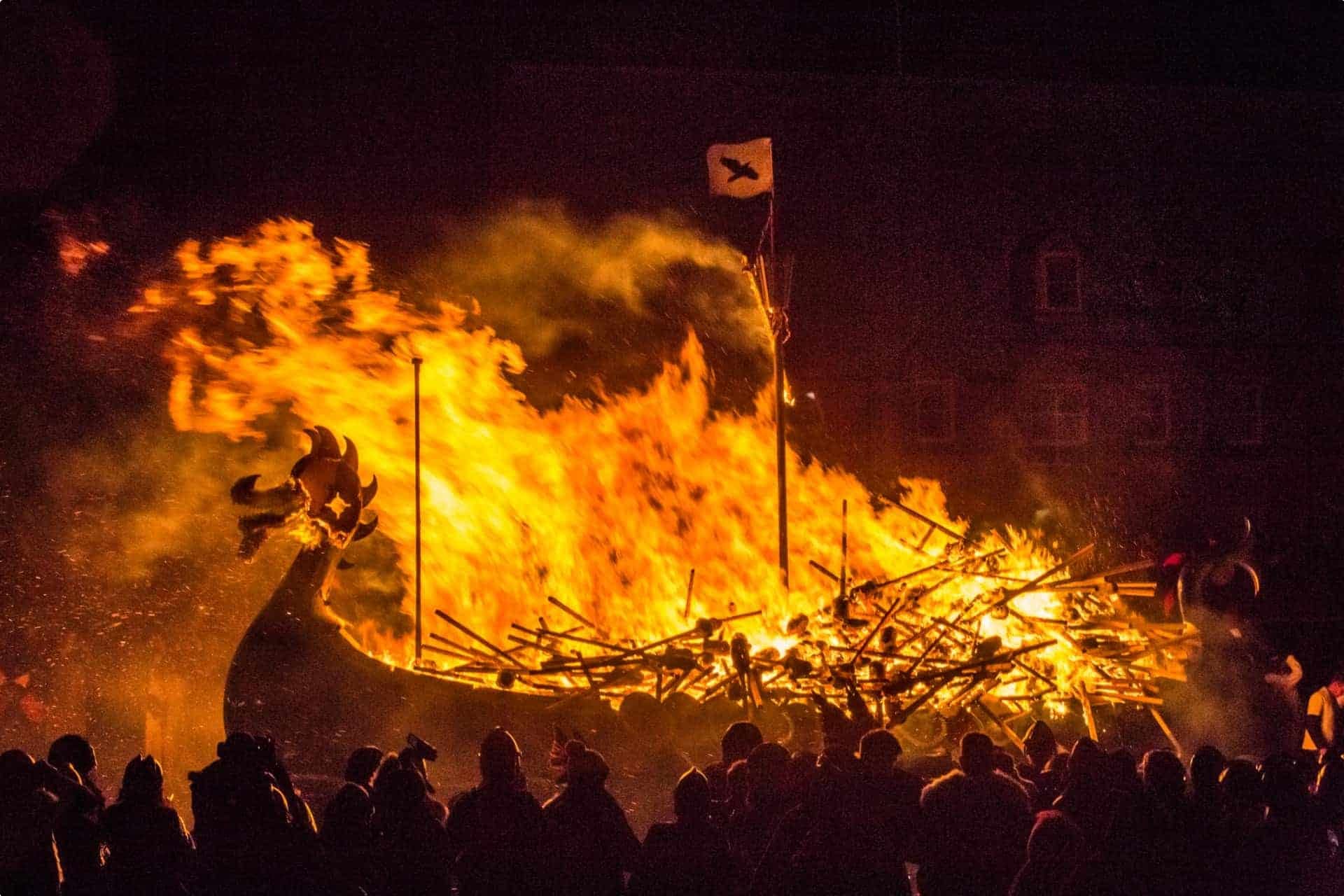
Shetland in the 20th Century
Shetland’s main export was fish, and for four centuries it sold salted fish to German towns through the Hanseatic League, a guild of German merchants who dominated northern European trade. Shetland’s trade with the German towns ended in 1707 when the Acts of Union united Scotland and England, and the salt duties imposed by the new British government proved too prohibitive for the German merchants to continue trading with Shetland.
This caused an economic slump and mass migration to the mainland as the people of Shetland could not make a living. Local merchants and landlords controlled fishing and farms, reducing workers to near-serfdom in order to avoid eviction. The population of Shetland dropped from more than 30,000 (1861) to just a little over 17,000 (1971).
Economic prospects began to improve around the 1960s, and development was propelled further with the discovery of North Sea oil in the 1970s. More than half of the United Kingdom’s North Sea oil is in the waters off Shetland. The Shetland Islands Council struck a deal, allowing it to have a share of oil revenues. It required oil companies to share a huge oil terminal at Sullom Voe, built in 1978, and pay a “disturbance payment” to the council. This payment was put into a charitable trust and was used to improve social care and other services and facilities that benefit the community. The Shetland Islands now has a population of 22,000.
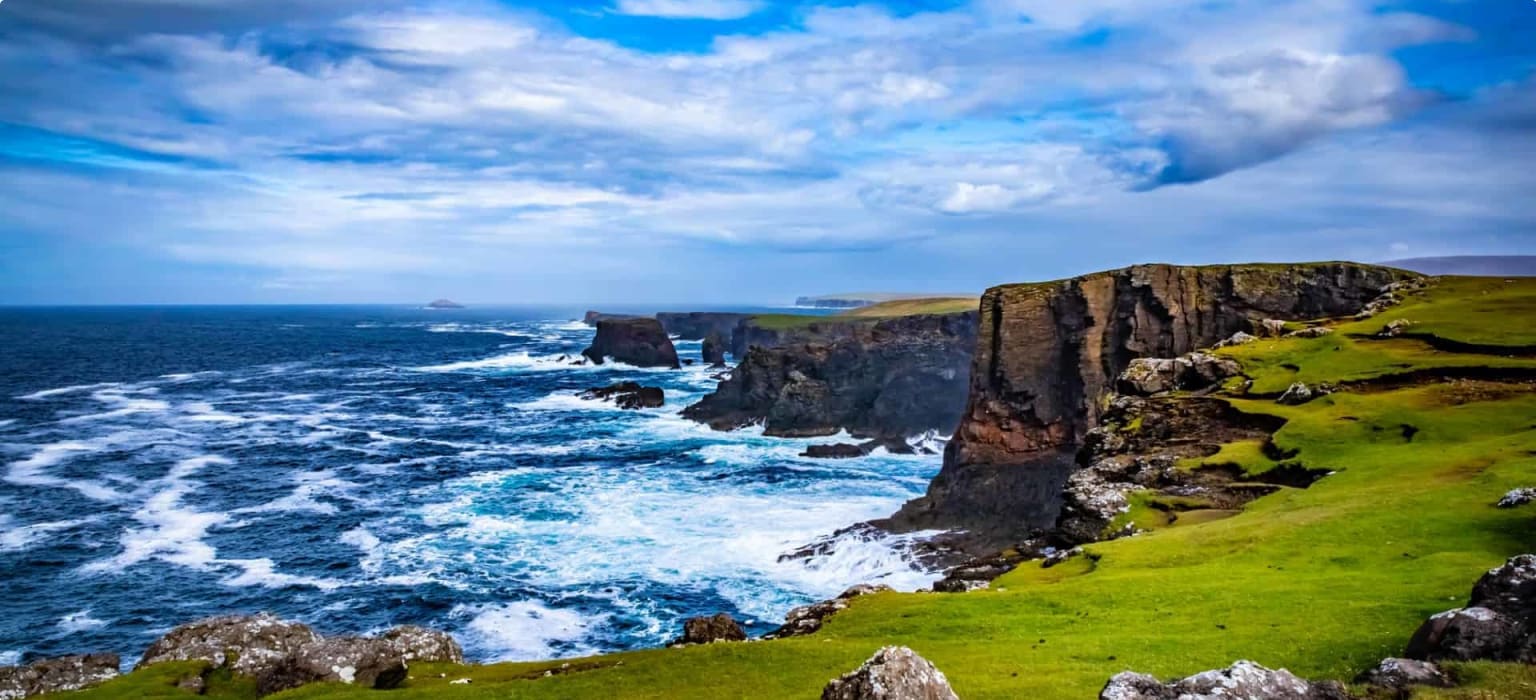
The economy of the Shetland Islands today
The fishing industry remains Shetland’s biggest sector, with the seafood industry worth £300m a year. Among its products are herring, mackerel, and bottom-dwelling whitefish, as well as farmed salmon and shellfish.
Just like in the Faroes, the land is mainly used for grazing native sheep, which are reared for their meat and wool, which has stimulated the local textile industry. Fruits and vegetables available on the islands are mostly imported, but Shetland also produces the Shetland Black, a variety of potato grown in the south of Mainland island, as well as carrots, cabbages, and kale.
Local shops include bakeries, breweries (the Shetland has two), and chocolate manufacturers. The Shetland’s Skibhoul Bakery, baking since 1885, produces unique Oceanic oatcakes, which are wheat-free and contain only three ingredients: Scottish oatmeal, vegetable oil, and water from the Atlantic.
Travelling to the Shetland Islands
In addition to oil, agriculture, textiles, and the fishing industry, tourism has also been an important source of revenue.
Even the Shetland Islands Council is quick to say that Shetland is “unlikely to become a mass-market destination” but it is appealing to travellers who value its seclusion, breathtaking scenery, and more than 3,000 kilometres of coastline against the vivid blue of the Atlantic. The Shetland Tourism Association also has plans to beef up the islands’ tourism industry, particularly during the winter months. If you are looking for an escape from the heat, stress and hustle and bustle that can sometimes accompany travelling, consider the Shetland Islands.
In the latest available statistics (2017), 73,000 tourists visited Shetland, a growth of 13% from 2013. The peak season is July and August, but every season has a unique attraction: the aurora borealis in winter, wildlife watching any time of the year, the festivals during the summer, and indoor attractions such as the Lerwick Museum when the weather is less than ideal for exploring.
A guide to the Shetland Islands
The main island of Shetland is called the Mainland. Mainland Shetland is home to Lerwick, the Islands’ biggest town, and has by far the biggest population, with 19,000 people. By far the biggest of the islands, it is also the arrival point for most tourists, and holds Shetland’s ferry and air connections.
To the north of Mainland Shetland are the islands of Yell, Unst, and Fetlar, and to the east are Bressay and Whalsay. The smaller islands of East and West Burra, Muckle Roe, Papa Stour, Trondra, and Vaila lie to the west of Mainland. Other inhabited islands are Foula, Housay, Fair Isle, and Out Skerries. The rest of the islands are uninhabited.
The island of Vaila, to the west of Mainland is notable for having the smallest population, with only two people!
Shetland Islands Weather
You may have heard of how Shetland ponies, a breed that developed on the island for centuries, are a tough and hardy breed as they had to contend with the harsh conditions of the island. Don’t let that scare you regarding Shetland weather! Though the Shetland Islands are as far north as St Petersburg in Russia, or Anchorage in Alaska, they thankfully are protected by the effect of warm ocean currents and therefore do not get as cold as other places on the same latitude. Nonetheless, you can expect the islands to be fairly chilly, no matter what time of year you go: the warmest day recorded in 2017 was in August at 14.7 degrees Celsius, and the coldest day was in December at 2.3 degrees Celsius.
Getting There
As the United Kingdom left the EU on 31 January 2020, there may be changes to visa and other rules. It is always advisable to check passport and visa regulations before travelling.
There are two main ways to get to Shetland: by ferry or by plane. Flying is undoubtedly quicker: it takes an hour to get to Shetland from Aberdeen and Bergen, and an hour and 30 minutes from Edinburgh or Glasgow. See the complete list here. A ferry from Aberdeen, Scotland to Lerwick in the Shetland Islands takes around 12 hours but you do get to cruise through the North Sea and take in the rugged, subarctic views.
Getting Around
Within the islands, visitors can use public transportation and travel by inter-island flights or ferries, or by bus. The short inter-island flights are from Tingwall Airport (just 10 km outside of Lerwick) and can take you to Fair Isle, Foula, Out Skerries and Papa Stour.
There are also numerous taxi companies all over Shetland.
To truly have the freedom to plan your day at your own pace, consider hiring a car or a bike.
Related Tours
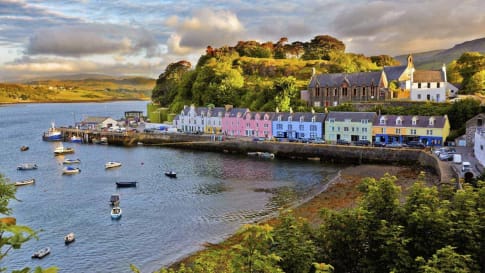
20 days
Jul, Sep, May, AugScottish Islands and Shetland small group tours for seniors
Visiting Scotland
An escorted small group tour for couples and solo travellers of the Scottish isles including the isle of Skye draws on local guides to share their knowledge of the destinations in this unique part of Scotland. UNESCO world heritage site are visited as breathtaking scenery and authentic experiences are shared in a group of like minded people on this guided tour of remote Scotland.
From A$16,695 AUD
View Tour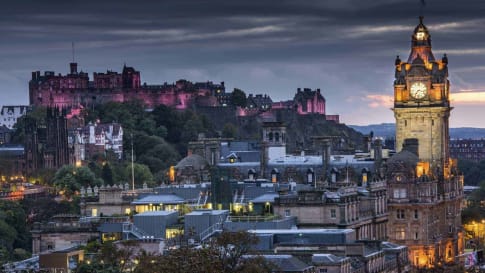
From A$15,995 AUD
View Tour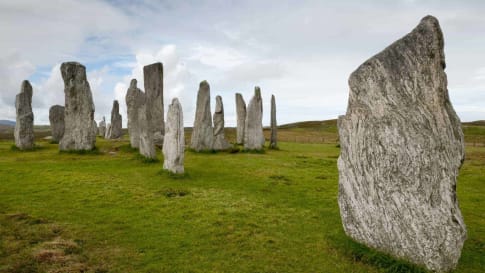
21 days
AugPrehistoric Britain small group history tour including standing stones
Visiting England, Scotland
This guided tour invites you to explore UNESCO World heritage sites at Skara Brae in the Orkneys, Isle of Skye, and Stonehenge in a prehistoric tour. This escorted tour has trips to key sites in Scotland, and the Irish sea in Wales such as Gower Peninsula and National Museum in Cardiff and England. Each day tour is supported by local guides.
From A$16,750 AUD
View Tour
9 days
AugEdinburgh Festival Fringe Small Group Tour
Visiting Scotland
One of the few European tour companies to have in Scotland an escorted small group tour of Edinburgh during the fringe festival. As well attending performances, this trip includes time to experience, the old town, new town and the royal mile, a UNESCO world heritage site plus Edinburgh Castle and Palace of Holyroodhouse.
From A$6,875 AUD
View Tour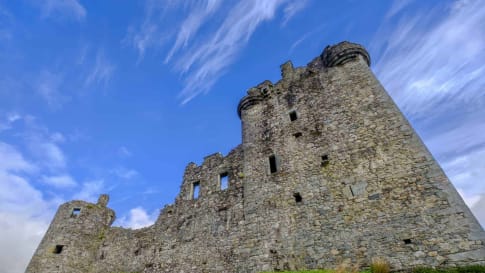
22 days
Jul, Sep, Jun, AugScotland small group tour | Tracing 5,000 years of history
Visiting Scotland
This guided tour of Scotland with a tour leader and local guides includes the isle of Skye, Orkney islands, the Scottish highlands with breathtaking scenery. Edinburgh including the royal mile, Palace of Holyroodhouse, Fort William, Urquhart castle, Stirling castle, loch lomond, Hadrians wall and New Lanark also a UNESCO World heritage site.
From A$15,995 AUD
View Tour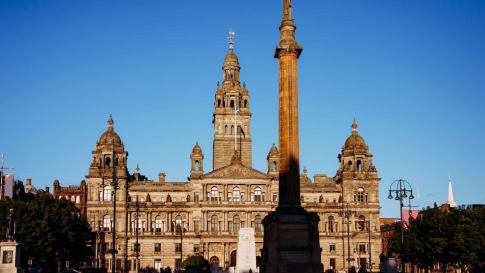
From A$13,915 AUD
View Tour
5 days
Jun, JulEdinburgh City Tour
Visiting Scotland
A guided tour of the capital of Scotland, Edinburgh is a day tour collection with a tour leader and local guides. The old town of Edinburgh including the Royal mile and New town of Edinburgh are a UNSECO world heritage site and are included in our itineraries as well the Palace of Holyroodhouse.
From A$4,580 AUD
View Tour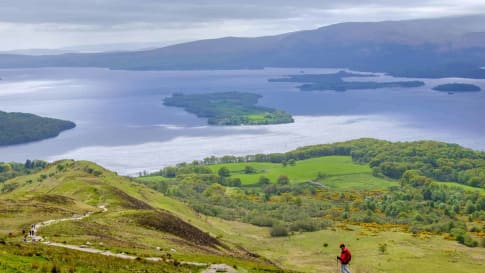
13 days
Jun, Aug, MayScotland's Great Trails Walking Tour
Visiting Scotland
An escorted walking tour of Scotland. This trip is mainly in the Scottish Highlands. Your tour leader guides you to Stirling Castle, Loch Lomond and Craignorms National park with experienced local guides. The tour for mature couples and solo travellers finishes in Edinburgh with time to visit Edinburgh Castle and the Royal mile a UNESCO World heritage site.
From A$11,560 AUD
View Tour
22 days
Apr, AugSeven Ages of Britain, snapshots of Britain through the ages.
Visiting England, Scotland
This guided small group tour starts in Scotland and finishes in England. On Orkney we have a day tour to the UNESCO World heritage site, Skara Brae, before travelling to city of York. Your tour leader continues to share the history from the Neolithic to the Victorian era. The tour concludes in the capital city, London.
From A$15,995 AUD
View Tour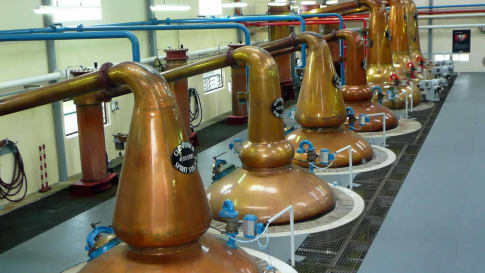
19 days
JulWhisky and Other Scottish Wonders
Visiting Scotland
A guided small group tour of Scotland is a day tour collection that includes Edinburgh, the royal mile, Edinburgh castle, and the old town a UNESCO World heritage site Experience and learn about, Kellie castle, St Andrews, Skye, Balmoral castle, Loch Lomond and Loch Ness as well touring the Scottish highlands to finish in Glasgow.
From A$17,525 AUD
View TourHighlights of the Shetland Islands and Places to Visit
Lerwick
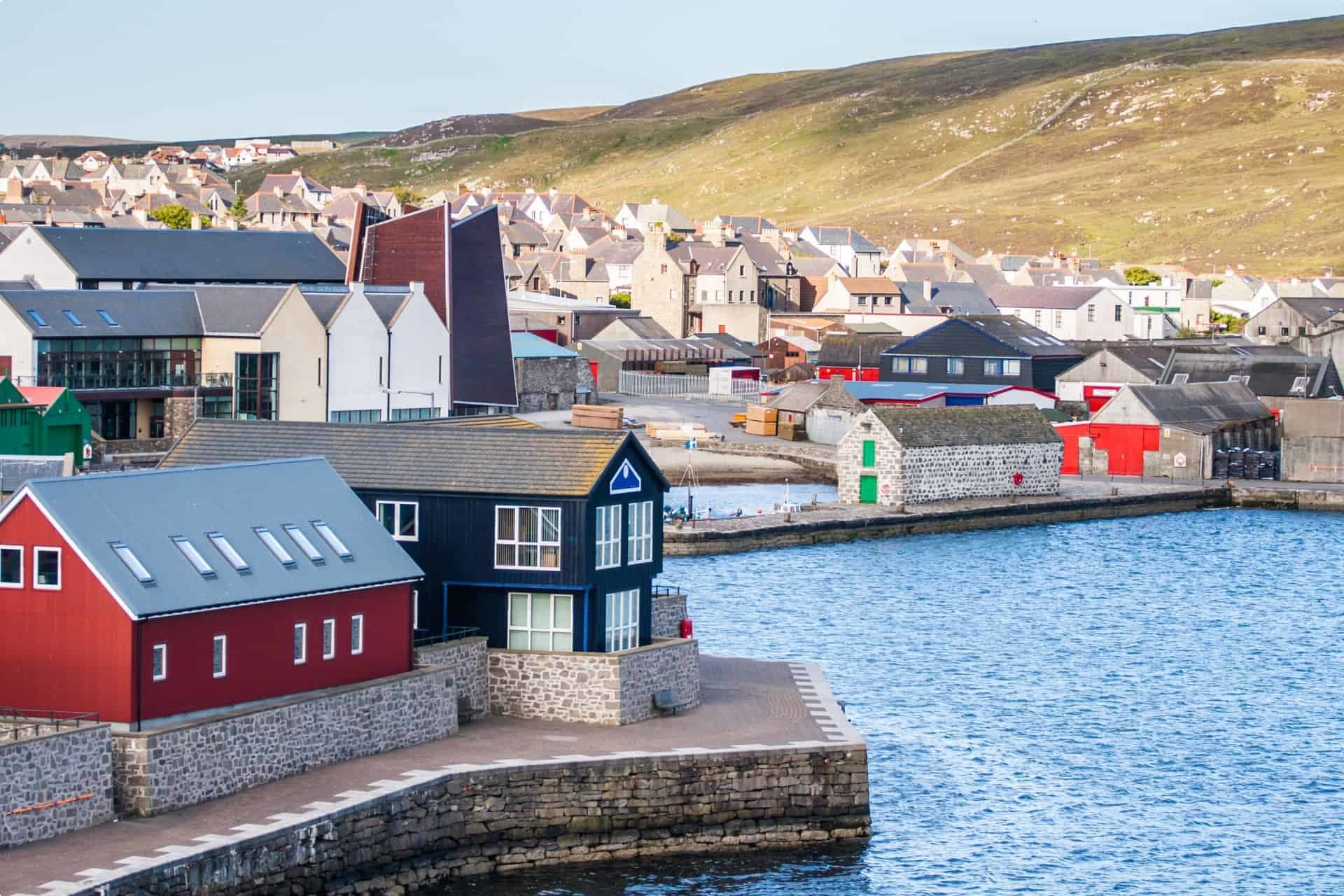
Lerwick is the islands’ beating heart. All of the banks, for one, are found in Lerwick’s old town centre, as well as the offices of Visit Shetland where travellers can sort out accommodation bookings and ask questions regarding their trip (Porter, 2010, p.12).
Despite its small size, Lerwick (from the Norn Leirvik meaning “muddy bay”) enjoys a variety of leisure and entertainment facilities that can be found on the Scottish mainland and in larger cities. It has an intriguing history: it was founded as an unofficial (or, shall we say, illegal) marketplace for 17th century Dutch herring fleets, and was, in short order, demolished by order of the Scalloway court (Scalloway was capital of Shetland before Lerwick), burnt by the Dutch, and incinerated by the French.
Against all odds, Lerwick rose from the ashes and became a bustling, modern city. Its largest open public space, located around the Clickimin Loch, is the Clickimin Centre with sports facilities, a leisure pool, and a well-equipped camping and caravan site. Birdwatchers will have a grand time at the loch, as they are sure to spot mallard and teal, as well as goldeneye and whooper Swans which uses the loch as a migration stopover.
South of the loch is Clickimin Broch, one of Shetland’s major archaeological sites. A broch is a prehistoric circular stone tower unique to Scotland. Clickimin Broch is one of around 500 of these stone structures found in Scotland, more than 100 of which still stand in Shetland (Porter, 2010, p.24).
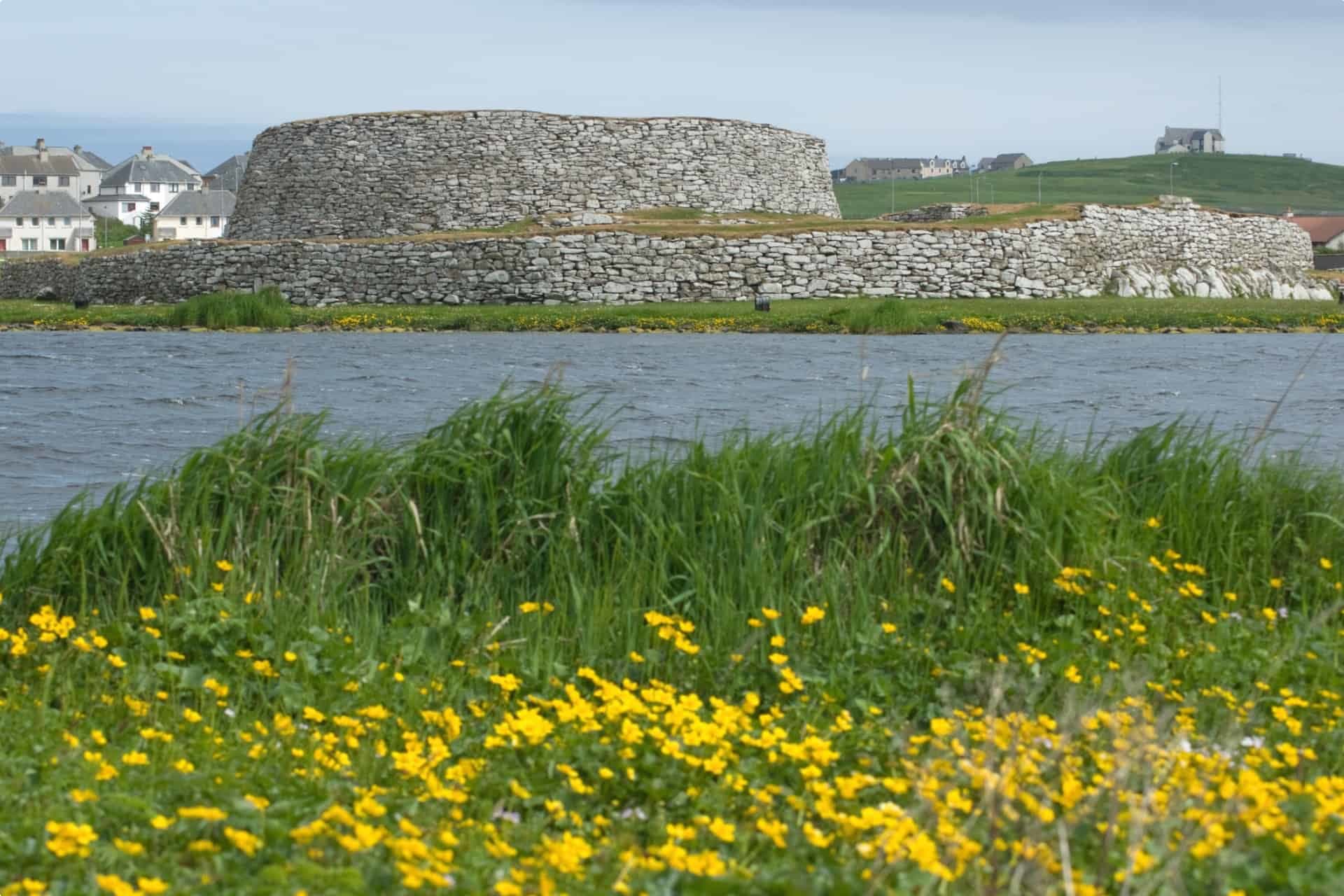
There is no better way to learn more about Lerwick and Shetland history than a visit to the Shetland Museum and Archives. The two main museum galleries have over 3,000 artefacts. Visitors can learn the Shetland story through thematic zones focused on customs and folklore, the change in culture from Norse to Scottish, and the positive and negative effects of the British government on the islands.
The museum sits on Hay’s Dock, which dates back to the 1820s. Also located at the historic port is Shetland’s music, cinema, and creative industries centre, Mareel, where visitors can watch films or sip coffee by the North Sea. Mareel also holds writing, arts and craft, and dance workshops.
Those unable to attend the Up Helly Aa festivities in winter can see the exhibition in the Galley Shed in summer. The Shetland Textile Museum is housed at The Böd, a restored fishing station and the birthplace of Arthur Anderson, a philanthropist and for many years a Member of Parliament for Shetland and Orkney. Visitors can view the textile collection and talk to skilled spinners and weavers.
Visitors can also walk from the Museum to the south end of Lerwick’s main street, Commercial Street, to experience the waterfront and view the lodberries (flat rocks which serves as a landing place for boats), where goods were once smuggled in and out of Lerwick.
Northmavine
Only the narrow isthmus at Mavis Grind joins Northmavine to the rest of the Mainland, making it almost an island of its own. Visitors can enjoy coastal walks that can take them up to Ronas Hill, Shetland’s highest point at 450 metres (1,475 feet). From this vantage point you’ll be able to see all of Shetland and, if the weather is clear, even as far as Fair Isle.
Learn more about Northmavine in the Tangwick Haa Museum and enjoy the dramatic ocean landscapes with a cup of tea at the Braewick Cafe.
Central Mainland
The Central Mainland islands are connected with the Mainland via bridges. The Burra Bridge will take you to the fishing village of Hamnavoe, where you can walk along the coast to the Fugla Ness lighthouse and along the fine sand of Meal Beach, Shetland’s most popular beach.
Also located in Central Mainland is Scalloway, Shetland’s capital until the 18th century. Scalloway is only 15 minutes away by car from Lerwick and supports a tiny population of 2,000 (Porter, 2010, p. 20). The town’s most notable feature is the infamous Scalloway Castle, built in 1600 using forced labour by the order of Patrick Stewart, the 2nd Earl of Orkney, who was made Lord of Shetland in 1590. In 1609, following complaints regarding his misrule of the islands, Stewart was imprisoned in Edinburgh and was executed in 1615.
The remains of his castle is in the care of Historic Scotland and can be viewed by the public.

Next to the castle is the Scalloway Museum, which houses a moving display about the heroes of the “Shetland Bus”. During World War II, the Shetland Bus (official name: Norwegian Naval Independent Unit), the Norwegian resistance who carried out clandestine naval operations against Nazi Germany, used Scalloway as its home base.
If you happen to be in the Shetland Islands in June and July, it is best to travel along the rich meadows of the amazing Tingwall Valley, which will be blanketed by the colours of Shetland’s native wild flowers, including several species of orchid.
South Mainland
This long, narrow peninsula runs about 40 kilometres south from Lerwick and is a treat for those longing for incredible scenery and those interested in prehistoric structures. Many of the places here are less than two kilometres (a mile) from the sea (Porter, 2010, p. 24), promising sandy beaches and sightings of seabirds.
Off the east coast, on Mousa Island, one can find the best preserved broch in the world. Mousa Broch rises to 13 metres with an internal diameter of six metres, virtually intact, including the stone staircase that present-day visitors can climb to enjoy the view. It can be reached by a short boat trip; there is also a special evening trip to watch storm petrels which return to nest in the walls of the broch (Porter, 2010, p.24).
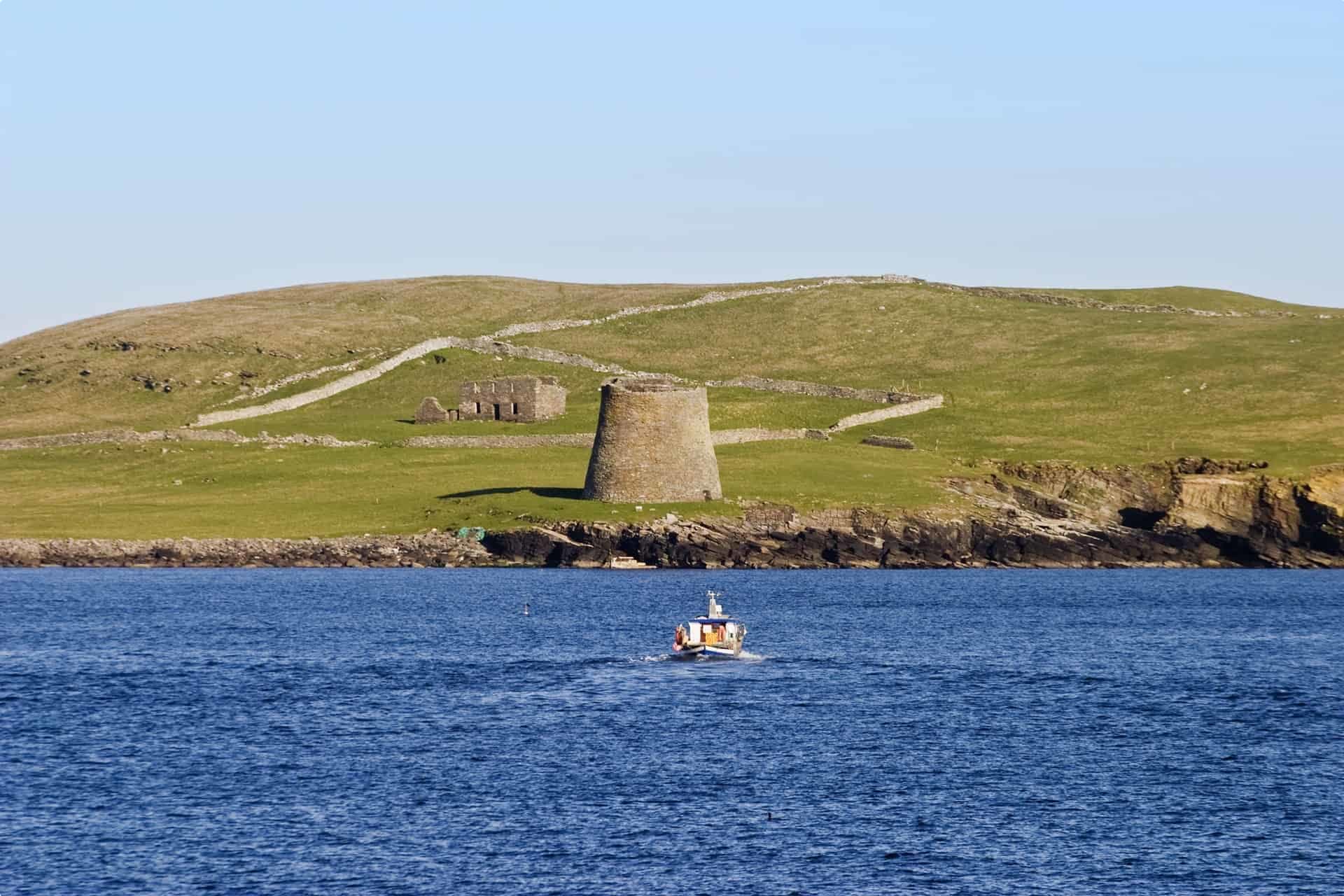
The South Mainland is also the location of Shetland’s most recently excavated archaeological sites, Old Scatness. The remains of this Iron Age Village, buried for 2,000 years, was first discovered by workmen–who dug up a broch–building the access road to the expanded Sumburgh Airport. Twenty years later, the Shetland Amenity Trust raised funding to excavate the site, and the more extensive digs revealed the remarkably well-preserved village which grew around the broch.
Visitors can go on a guided tour of this exciting archaeological treasure during the summer months. There are recreated Iron Age and Pictish buildings, as well as Living History demonstrations which bring the village to life.
Beyond Old Scatness is another prehistoric settlement called Jarlshof, which was discovered after storms unveiled its stonework. As the settlement was in use until the 1600s, it has a wealth of artefacts from various historical ages: Bronze Age homes, Iron Age wheelhouses, Norse long houses, and structures from the Middle Ages and the 1500s.

Sumburgh Head is the southernmost tip of the Shetland mainland, which features Shetland’s first lighthouse, built by engineer Robert Stevenson, grandfather to novelist Robert Louis Stevenson. Also in Sumburgh Head is a nature reserve run by the Royal Society for the Protection of Birds. Between April and July, visitors can see the puffins that alight here.
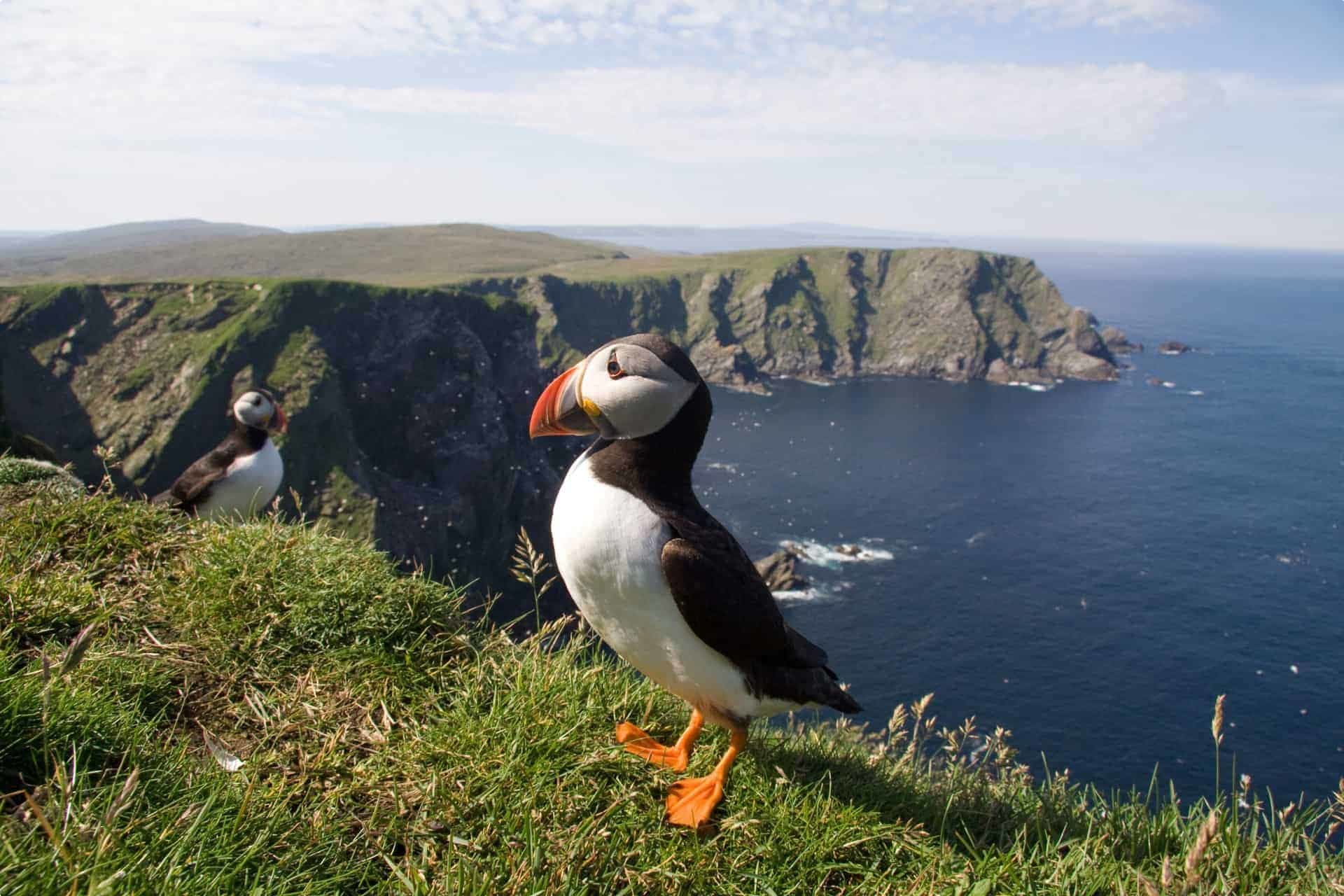
Visitors can also explore St Ninian’s Isle, which is connected to the mainland by a sandbar (also called a tombolo or ayre) that emerges during the summer and is covered by the tide during winter.
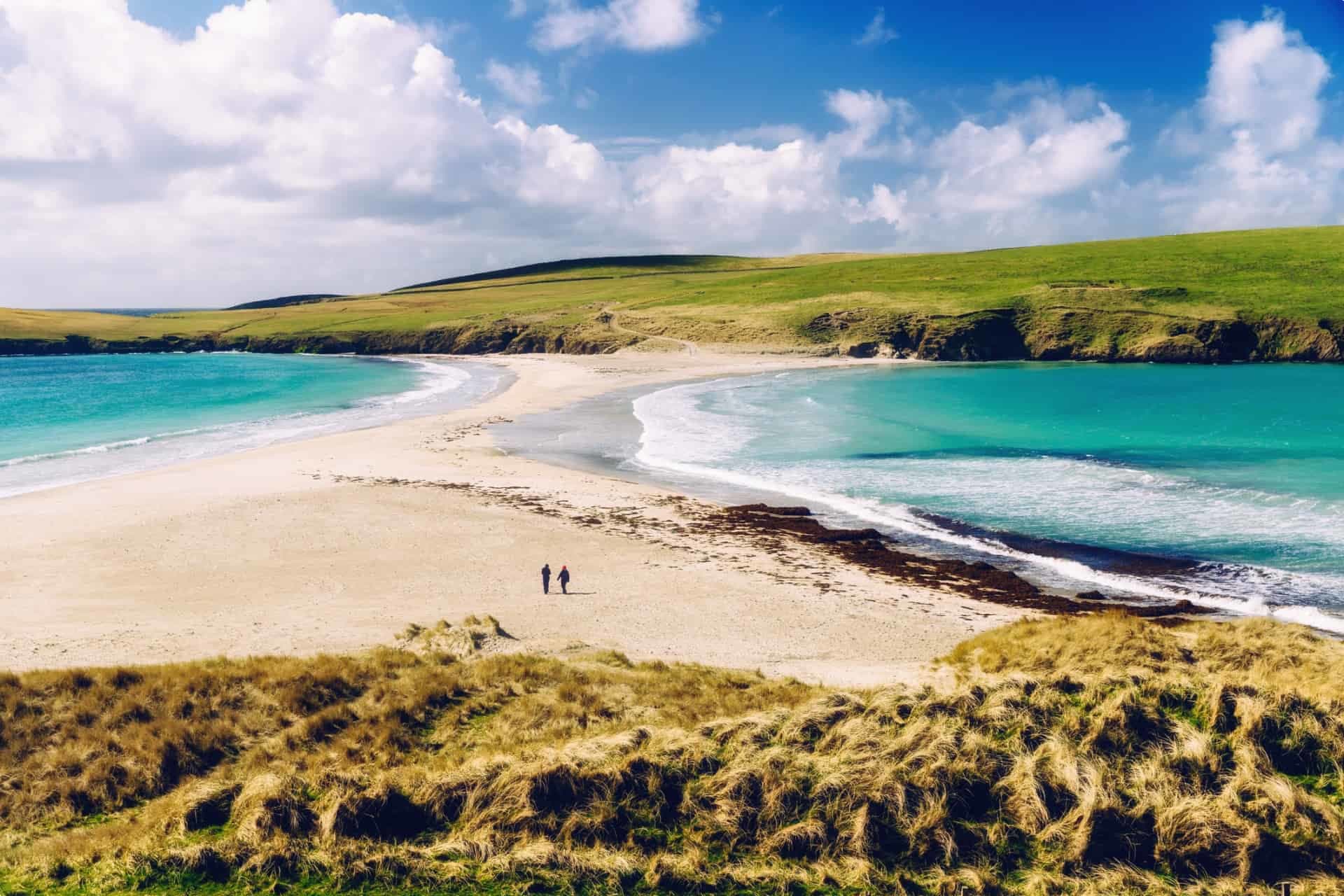
The island became famous in 1958 with the discovery of silver bowls and ornaments dating back to the year 800 during an archaeological dig. These discoveries are now saved in the Museums of Scotland in Edinburgh. No one inhabits St Ninian’s Isle save for sheep, and is perfect for an idyllic picnic or coastal walk. St Ninian’s Isle is regularly compared to the tropical beaches of the Caribbean due to its pristine, white sandy beaches and gliterring water.
Small group tours Shetland Islands
These are only a few of the many places to discover and explore in Shetland. For those who want to learn more about the islands, Shetland.org is a good resource, as well as Lindsey Porter’s Shetland Islands (The Horizon Press, 2010). Both of these references, as well as a variety of online resources, were consulted for this article.
Every year, Odyssey Traveller researches and designs new tours for senior travellers. Our small group educational tours and guided walking holidays provide focused attention and an immersive experience that may be hard to find with other travel groups.
We have several tours to Scotland, including the 20-day Scottish Isles small group tour. Our tours of Scotland’s islands and its Neolithic sites begins in Glasgow, before heading to the Isle of Mull and Isle of Skye in the Inner Hebrides. We then head to the Orkney and Shetland Islands, before wrapping up in Edinburgh, with plenty of other stops along the way. Just click through to sign up. This program is quite popular among our participants: as of March 2019, three departures are guaranteed, which means the tours have reached the minimum number of participants required to operate the tour and will proceed this year and in 2020 (terms and conditions apply). Happy travelling!
Originally published March 24, 2019.
Updated on October 11, 2019.
Updated July 2021.



